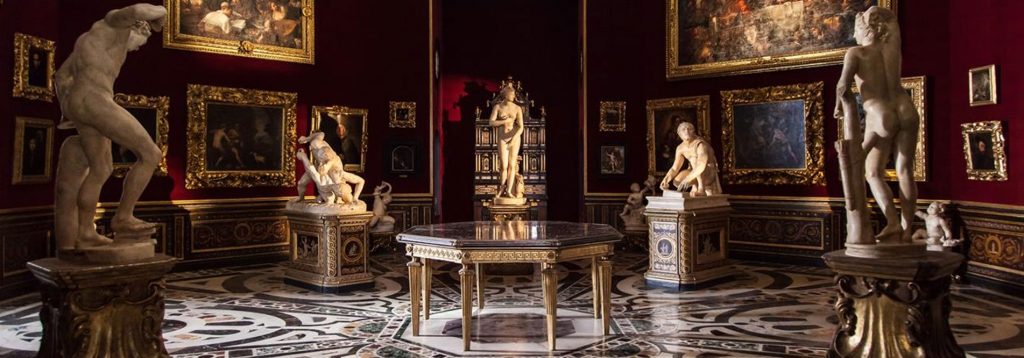
Museums
Pitti Palace
Palazzo Pitti was built in 1458 by one of the richest and most powerful families of the era, the Pittis – business rivals of the Medici family. The appointment was given to Brunelleschi who built what today corresponds only to the central part of the Palace. It currently houses the Palatine Gallery (housing works by Raffaello, Giorgione, Tiziano and Rubens), the Gallery of Modern Art, the Silver Museum and the Carriage Museum. The famous Boboli Garden is reached through the main entrance of the Pitti Palace.
Uffizi Palace
It contains the prestigious Uffizi Art Gallery. The building, a wonderful architectural work of Vasari, was begun in 1560 by Vasari and terminated in 1580 by Buontalenti. The Gallery houses some of Italy and the world’s most important works of art, including the “Birth of Venus” and the “Primavera” by Botticelli and the “Tondo Doni” by Michelangelo.
Bargello Museum
The Bargello Palace was built to house first the “Capitano del Popolo” and later, in 1261, the “Podestà”, the highest magistrate of the Florence City Council. This “Palazzo del Podestà”, as it was originally called, is the oldest public building in Florence. The museum houses some of the early masterpieces of Michelangelo, the “David” by Donatello, many works from the Della Robbia family, while Benvenuto Cellini is represented with his bronze Bust of Cosimo I. The museum also houses a fine collection of Maiolica ceramics, textile, tapestries, ivory, silver, armours and old coins. The XIII century interior courtyard was remodeled in the course of history.
Accademia Gallery
Planned in 1781 by Gaspare Maria Paoletti, it is part of the complex that also includes San Marco Church and Museum, the Opificio delle Pietre Dure and the Museum of Musical Instruments. It was conceived by Pietro Leopoldo in order to facilitate the study of the students of Fine Arts. The most important work in the Gallery is the David by Michelangelo, that was previously located in Piazza della Signoria. In the other rooms, there are the plaster cast model of the statue “Il Ratto delle Sabine” by Giambologna, the “Prigioni” by Michelangelo and several works belonging to Michelangelo’s school.
Opificio delle Pietre Dure
Founded in 1588 by the Grand Duke Ferdinando I, it was one of the oldest handcraft and artistic factories of the Grand Ducal period. It houses works made of semiprecious stones and polychrome marbles, canary glasses, stone paintings, oil paintings and tools for the manufacturing of these materials, besides a rich selection of stones manufactured between the 17th and 18th century.
Church and Museum of Orsanmichele
The XIII century building used to be the Oratory of San Michele, that’s the origin of the name “Orsanmichele”. It became a place of worship in the XV century, when it was turned into the church representing the Arts and Guilds that commisioned the statues for the external aedicules, dedicated to the patron saints. They were later placed in the museum on the first and second floor and replaced by copies.
San Marco Museum
It is located inside the ex convent of the Dominican friars, that was restored and enlarged by Michelozzo on commission by Cosimo il Vecchio de’ Medici. Besides the works by Angelico, the museum hosts a magnificent “Last Supper” frescoed by Ghirlandaio at the end of the XVI century and, in the Library a fine collection of books belonging to the Enlightenment. Precious relics and a rare collection of bells are exhibited in the cellars.
